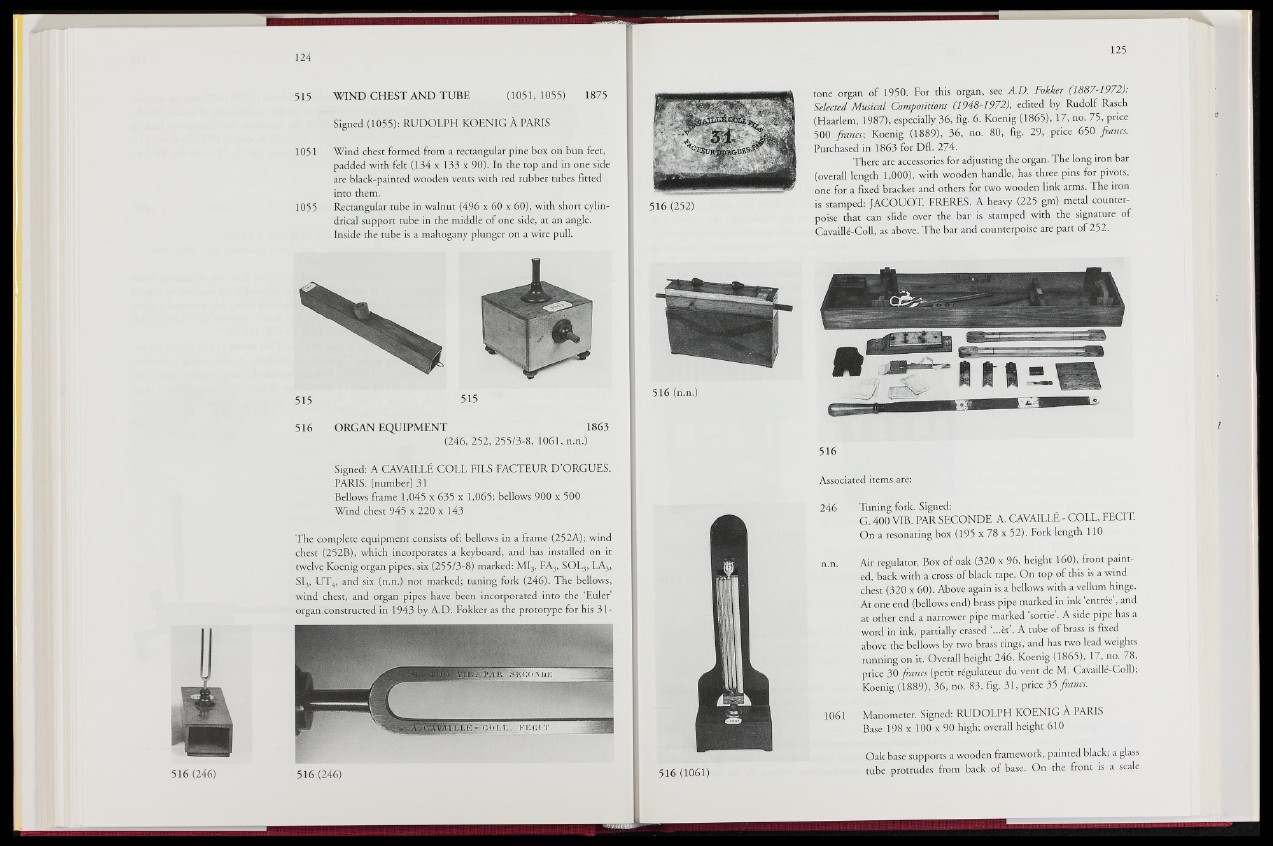
515
1051
1055
WIND CHEST AND TUBE (1051, 1055) 1875
Signed (1055): RUDOLPH KOENIG A PAMS
Wind chest formed from a rectangular pine box on bun feet,
padded with felt (134 x 133 x 90). In the top and in one side
are black-painted wooden vents with red rubber tubes fitted
into them.
Rectangular tube in walnut (496 x 60 x 60), with short cylindrical
support tube in the middle of one side, at an angle.
Inside the tube is a mahogany plunger on a wire pull.
516 ORGAN EQUIPMENT 1863
(246, 252, 255/3-8, 1061, n.n.)
Signed: A CAVA IT I.E. COLL FILS FACTEUR D’ORGUES.
PARIS, [number] 31
Bellows frame 1,045 x 635 x 1,065; bellows 900 x 500
Wind chest 945 x 220 x 143
The complete equipment consists of: bellows in a frame (252A); wind
chest (252B), which incorporates a keyboard, and has installed on it
twelve Koenig organ pipes, six (255/3-8) marked: MI3, FA3, SOL3, LA3,
SI3, UT4, and six (n.n.) not marked; tuning fork (246). The bellows,
wind chest, and organ pipes have been incorporated into the ‘Euler’
organ.constructed in 1943 by A.D. Fokker as the prototype for his 31-
516 (246) 516 (246)
tone organ of 1950. For this organ, see A.D. Fokker (1887-1972):
Selected Musical Compositions (1948-1972), edited by Rudolf Rasch
(Haarlem, 1987), especially 36, fig. 6. Koenig (1865), 17, no. 75, price
500 francs; Koenig (1889), 36, no. 80, fig. 29, price 650 francs.
Purchased in 1863 for Dfl. 274.
There are accessories for adjusting the organ. The long iron bar
(overall length 1,000), with wooden handle, has three pins for pivots,
one for a fixed bracket and others for two wooden link arms. The iron
is stamped: JACOUOT. FRERES. A heavy (225 gm) metal counterpoise
that can slide over the bar is stamped with the signature of
Cavailli-Coll, as above. The bar and counterpoise are part of 252.
1
516
Associated items are:
246 Tuning fork. Signed:
G. 400 VIB. PAR SECONDE A. CAVAILLÉ - COLL, FECIT.
On a resonating box (195 x 78 x 52). Fork length 110
n.n. Air regulator. Box of oak (320 x 96, height 160), front painted,
back with a cross of black tape. On top of this is a wind
chest (320 x 60). Above again is a bellows with a vellum hinge.
At one end (bellows end) brass pipe marked in ink ‘entrée, and
at other end a narrower pipe marked ‘sortie’. A side pipe has a
word in ink, partially erased ‘...èt’. A tube of brass is fixed
above the bellows by two brass rings, and has two lead weights
running on it. Overall height 246. Koenig (1865), 17, no. 78,
price 30 francs (petit régulateur du vent de M. Cavaillé-Coll);
Koenig (1889), 36, no. 83, fig. 31, price 35 francs.
1061 Manometer. Signed: RUDOLPH KOENIG À PAMS
Base 198 x 100 x 90 high; overall height 610
Oak base supports a wooden framework, painted black; a glass
tube protrudes from back of base. On the front is a scale